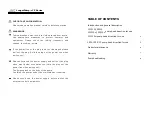
FXAlg #905: EQ Morpher ¥ FXAlg #906: Mono EQ Morpher
Algorithm Reference-125
PAGE 3
In/Out
When set to ÒInÓ the algorithm is active; when set to ÒOutÓ the algorithm is bypassed.
Out Gain
An overall level control of the EQ Morpher output.
Out Pan
Provides panning of the output signal between left and right output channels. A setting
of -100% is panned left and 100% is panned right. For EQ Morph, this is a stereo panner
which pans the entire stereo image, the same way the input sends on a KDFX INPUT
page are handled, when set to the ÒSPÓ mode.
Out Width
The width of the stereo Þeld is controlled by this parameter. A setting of 100% is the
same full width as the input signal. At 0% the left and right channels are narrowed to the
point of being mono. Negative values reverse the left and right channels. [EQ Morpher
only]
Morph A>B
When set to 0% the ÒAÓ parameters are controlling the Þlters, and when set to 100%, the
ÒBÓ parameters control the Þlters. Between 0 and 100%, the Þlters are at interpolated
positions. When morphing from A to B settings, the A Þlter #1 will change to the B Þlter
#1, A Þlter #2 moves to B Þlter #2, and so on. This is an excellent candidate for
assignment to a real-time KDFX Modulation.
FreqScale
The Þlter frequencies for the A and B parameter sets may be offset with the FreqScale
parameters. After setting the Þlter parameters, the FreqScale parameters will move each
of the four Þlter frequencies together by the same relative pitch.This, too, is an excellent
candidate for assignment to a real-time KDFX Modulation.
For the two Þlter sets A & B, there are four Þlters 1, 2, 3 and 4:
Freq
The center frequency of the bandpass Þlter peak in Hz. This frequency may be offset by
the FreqScale parameter.
Width
The bandwidth of the bandpass Þlter in octaves. Narrow bandwidths provide the most
convincing vocal sounds.
Gain
The level of the bandpass Þlter output. At 0 dB, a sine wave at the same frequency as the
Þlter will be neither boosted nor cut. At settings greater than 0 dB, the (hypothetical) sine
wave is boosted, and below 0 dB the sine wave is cut. Signals at frequencies other than
the Þlter frequency are always cut more than a signal at the Þlter frequency. The amount
that other frequencies are cut depends on the bandwidth of the bandpass Þlter.
A Freq 3
16 to 25088 Hz
B Freq 3
16 to 25088 Hz
A Width 3
0.010 to 5.000 oct
B Width 3
0.010 to 5.000 oct
A Gain 3
-79.0 to 24.0 dB
B Gain 3
-79.0 to 24.0 dB
A Freq 4
16 to 25088 Hz
B Freq 4
16 to 25088 Hz
A Width 4
0.010 to 5.000 oct
B Width 4
0.010 to 5.000 oct
A Gain 4
-79.0 to 24.0 dB
B Gain 4
-79.0 to 24.0 dB
















































